Abstract
Penicillium chrysogenum L2, a lysine auxotroph blocked in the early steps of the lysine pathway before 2-aminoadipic acid, was able to synthesize penicillin when supplemented with lysine. The amount of penicillin produced increased as the level of lysine in the media was increased. The same results were observed in resting-cell systems. Catabolism of [U-14C]lysine by resting cells and batch cultures of P. chrysogenum L2 resulted in the formation of labeled saccharopine and 2-aminoadipic acid. Formation of [14C]saccharopine was also observed in vitro when cell extracts of P. chrysogenum L2 and Wis 54-1255 were used. Saccharopine dehydrogenase and saccharopine reductase activities were found in cell extracts of P. chrysogenum, which indicates that lysine catabolism may proceed by reversal of the two last steps of the lysine biosynthetic pathway. In addition, a high lysine:2-ketoglutarate-6-aminotransferase activity, which converts lysine into piperideine-6-carboxylic acid, was found in cell extracts of P. chrysogenum. These results suggest that lysine is catabolized to 2-aminoadipic acid in P. chrysogenum by two different pathways. The relative contribution of lysine catabolism in providing 2-aminoadipic acid for penicillin production is discussed.
Full text
PDF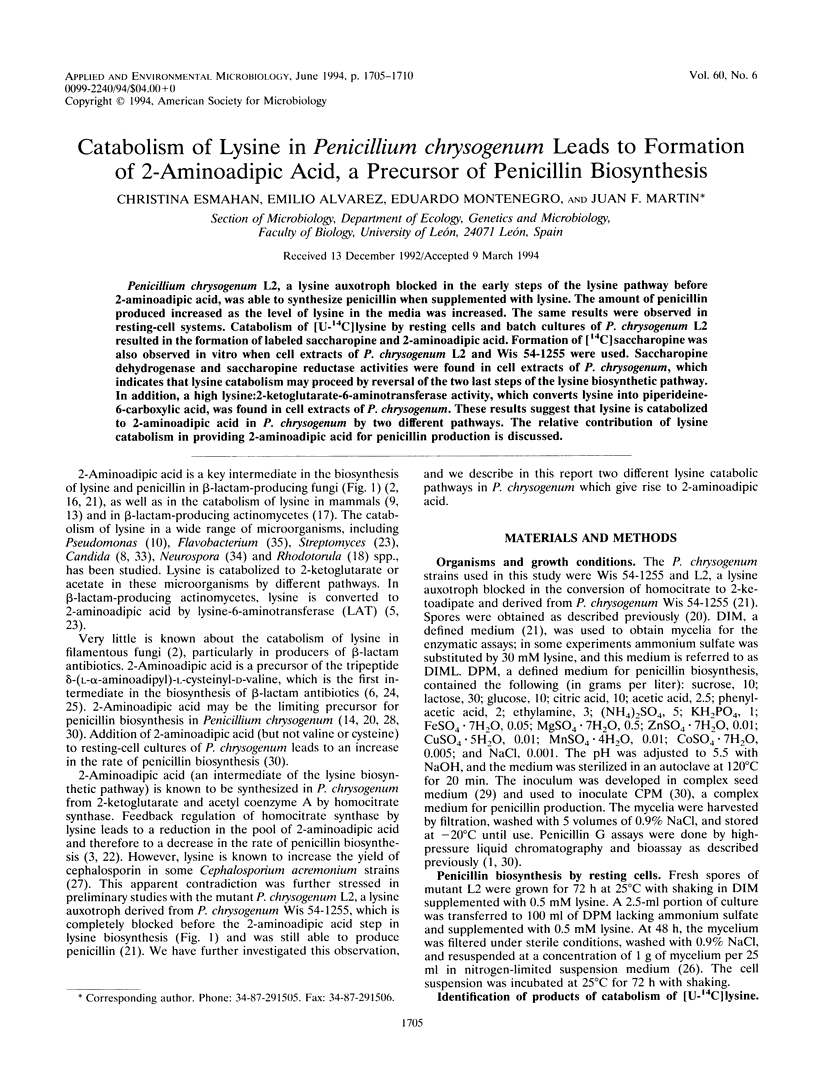
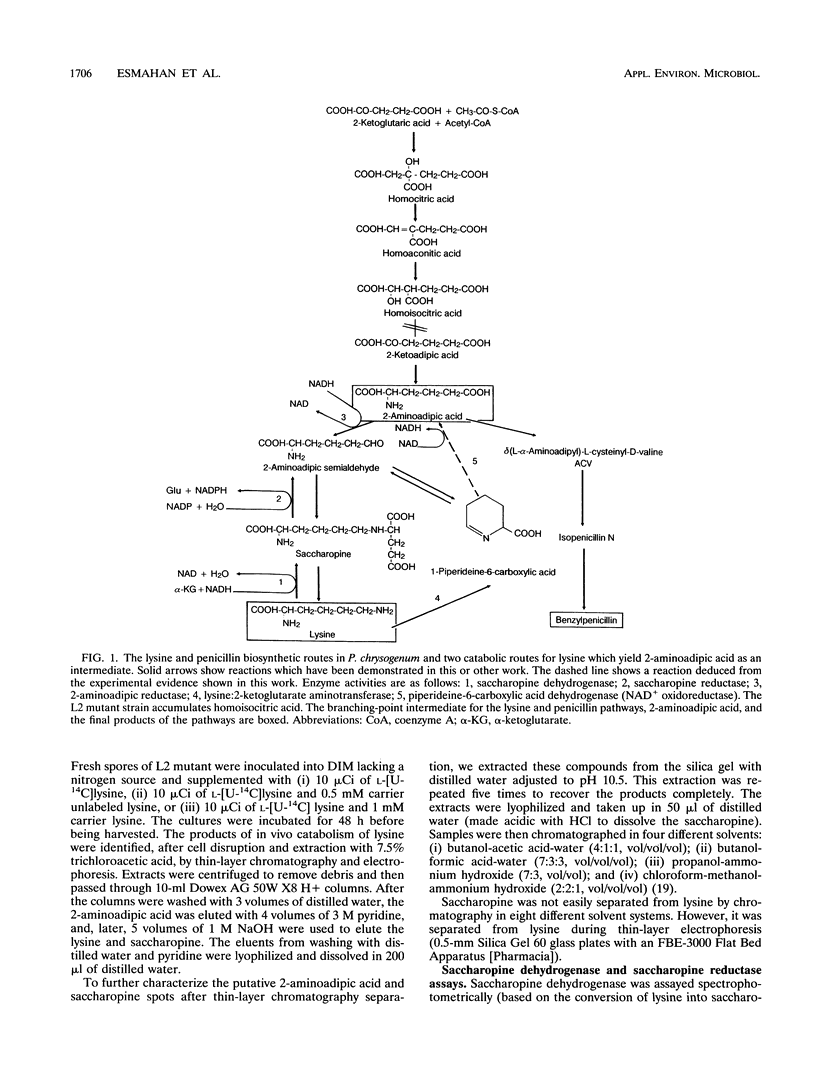
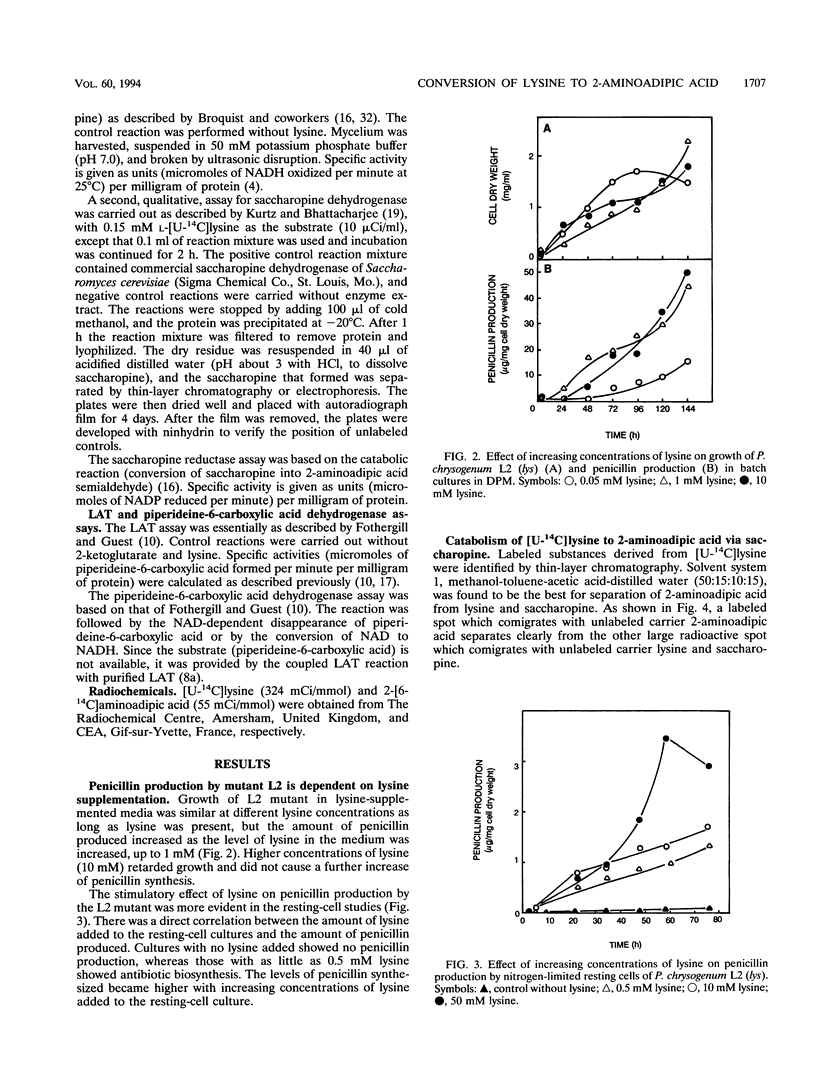
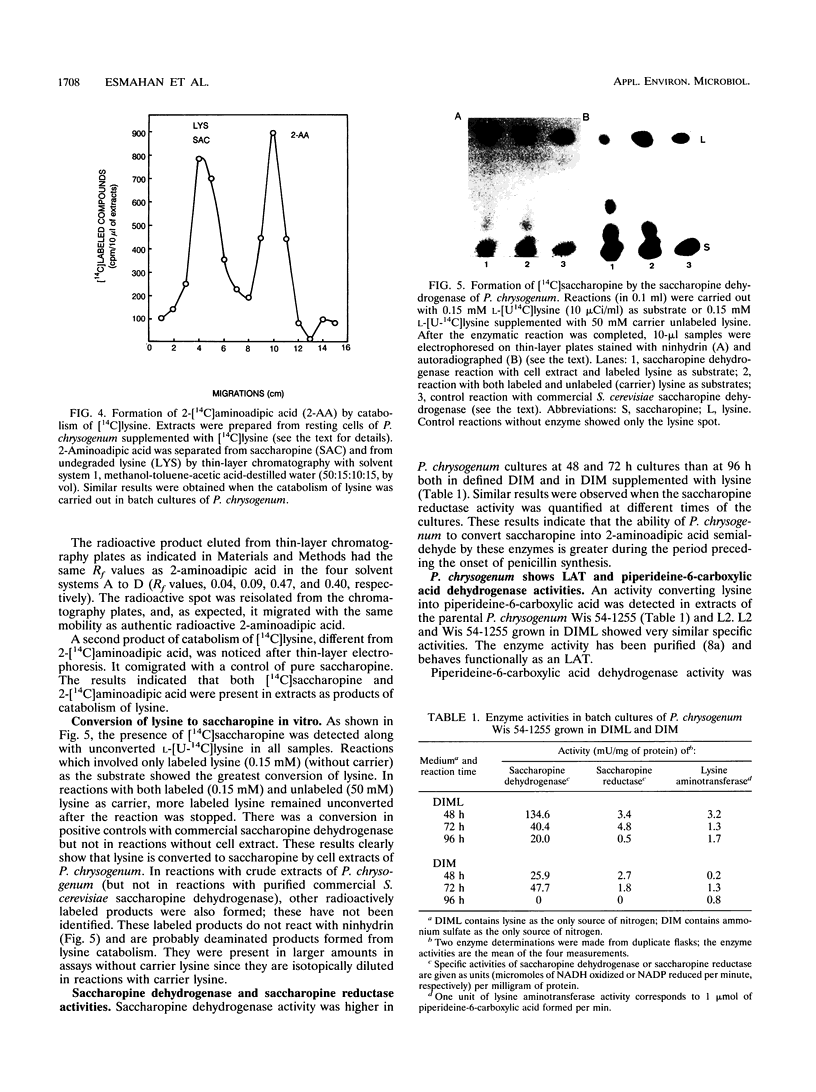
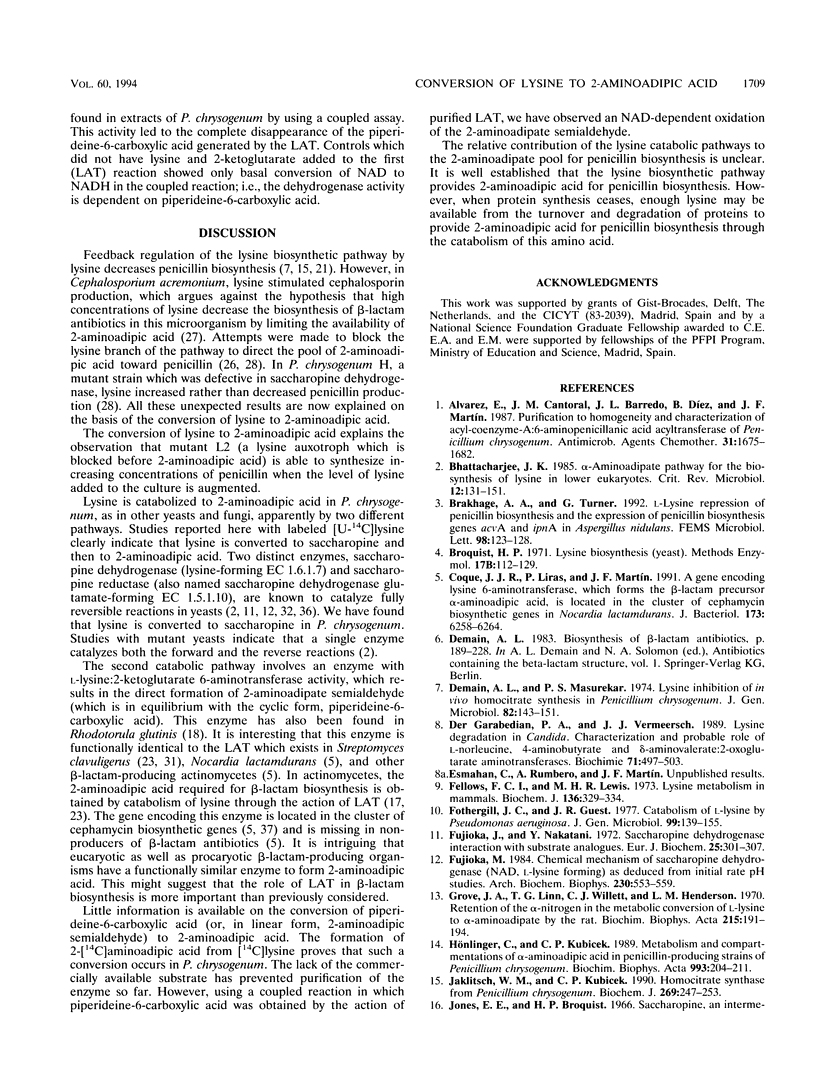
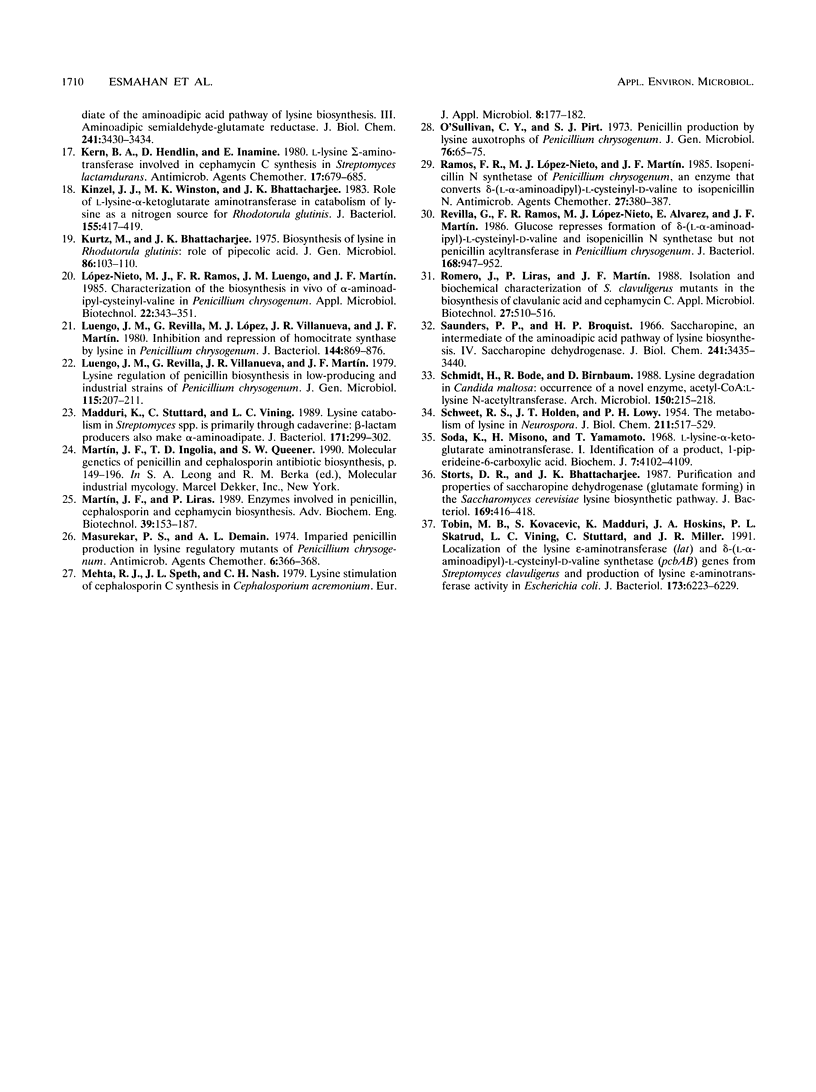
Images in this article
Selected References
These references are in PubMed. This may not be the complete list of references from this article.
- Alvarez E., Cantoral J. M., Barredo J. L., Díez B., Martín J. F. Purification to homogeneity and characterization of acyl coenzyme A:6-aminopenicillanic acid acyltransferase of Penicillium chrysogenum. Antimicrob Agents Chemother. 1987 Nov;31(11):1675–1682. doi: 10.1128/aac.31.11.1675. [DOI] [PMC free article] [PubMed] [Google Scholar]
- Bhattacharjee J. K. alpha-Aminoadipate pathway for the biosynthesis of lysine in lower eukaryotes. Crit Rev Microbiol. 1985;12(2):131–151. doi: 10.3109/10408418509104427. [DOI] [PubMed] [Google Scholar]
- Brakhage A. A., Turner G. L-lysine repression of penicillin biosynthesis and the expression of penicillin biosynthesis genes acvA and ipnA in Aspergillus nidulans. FEMS Microbiol Lett. 1992 Nov 1;77(1-3):123–127. doi: 10.1016/0378-1097(92)90142-b. [DOI] [PubMed] [Google Scholar]
- Coque J. J., Liras P., Laiz L., Martín J. F. A gene encoding lysine 6-aminotransferase, which forms the beta-lactam precursor alpha-aminoadipic acid, is located in the cluster of cephamycin biosynthetic genes in Nocardia lactamdurans. J Bacteriol. 1991 Oct;173(19):6258–6264. doi: 10.1128/jb.173.19.6258-6264.1991. [DOI] [PMC free article] [PubMed] [Google Scholar]
- Demain A. L., Masurekar P. S. Lysine inhibition of in vivo homocitrate synthesis in Penicillium chrysogenum. J Gen Microbiol. 1974 May;82(1):143–151. doi: 10.1099/00221287-82-1-143. [DOI] [PubMed] [Google Scholar]
- Der Garabedian P. A., Vermeersch J. J. Lysine degradation in Candida. Characterization and probable role of L-norleucine-leucine, 4-aminobutyrate and delta-aminovalerate:2-oxoglutarate aminotransferases. Biochimie. 1989 Apr;71(4):497–503. doi: 10.1016/0300-9084(89)90180-6. [DOI] [PubMed] [Google Scholar]
- Fellows F. C., Lewis M. H. Lysine metabolism in mammals. Biochem J. 1973 Oct;136(2):329–334. doi: 10.1042/bj1360329. [DOI] [PMC free article] [PubMed] [Google Scholar]
- Fothergill J. C., Guest J. R. Catabolism of L-lysine by Pseudomonas aeruginosa. J Gen Microbiol. 1977 Mar;99(1):139–155. doi: 10.1099/00221287-99-1-139. [DOI] [PubMed] [Google Scholar]
- Fujioka M. Chemical mechanism of saccharopine dehydrogenase (NAD+, L-lysine-forming) as deduced from initial rate pH studies. Arch Biochem Biophys. 1984 May 1;230(2):553–559. doi: 10.1016/0003-9861(84)90436-3. [DOI] [PubMed] [Google Scholar]
- Fujioka M., Nakatani Y. Saccharopine dehydrogenase. Interaction with substrate analogues. Eur J Biochem. 1972 Feb 15;25(2):301–307. doi: 10.1111/j.1432-1033.1972.tb01697.x. [DOI] [PubMed] [Google Scholar]
- Grove J. A., Linn T. G., Willett C. J., Henderson L. M. Retention of the alpha-nitrogen in the metabolic conversion of L-lysine to alpha-aminoadipate by the rat. Biochim Biophys Acta. 1970 Jul 21;215(1):191–194. doi: 10.1016/0304-4165(70)90404-6. [DOI] [PubMed] [Google Scholar]
- Jaklitsch W. M., Kubicek C. P. Homocitrate synthase from Penicillium chrysogenum. Localization, purification of the cytosolic isoenzyme, and sensitivity to lysine. Biochem J. 1990 Jul 1;269(1):247–253. doi: 10.1042/bj2690247. [DOI] [PMC free article] [PubMed] [Google Scholar]
- Kern B. A., Hendlin D., Inamine E. L-lysine epsilon-aminotransferase involved in cephamycin C synthesis in Streptomyces lactamdurans. Antimicrob Agents Chemother. 1980 Apr;17(4):679–685. doi: 10.1128/aac.17.4.679. [DOI] [PMC free article] [PubMed] [Google Scholar]
- Kinzel J. J., Winston M. K., Bhattacharjee J. K. Role of L-lysine-alpha-ketoglutarate aminotransferase in catabolism of lysine as a nitrogen source for Rhodotorula glutinis. J Bacteriol. 1983 Jul;155(1):417–419. doi: 10.1128/jb.155.1.417-419.1983. [DOI] [PMC free article] [PubMed] [Google Scholar]
- Kurtz M., Bhattacharjee J. K. Biosynthesis of lysine in Rhodotorula glutinis: role of pipecolic acid. J Gen Microbiol. 1975 Jan;86(1):103–110. doi: 10.1099/00221287-86-1-103. [DOI] [PubMed] [Google Scholar]
- Luengo J. M., Revilla G., López M. J., Villanueva J. R., Martín J. F. Inhibition and repression of homocitrate synthase by lysine in Penicillium chrysogenum. J Bacteriol. 1980 Dec;144(3):869–876. doi: 10.1128/jb.144.3.869-876.1980. [DOI] [PMC free article] [PubMed] [Google Scholar]
- Luengo J. M., Revilla G., Villanueva J. R., Martín J. F. Lysine regulation of penicillin biosynthesis in low-producing and industrial strains of Penicillium chrysogenum. J Gen Microbiol. 1979 Nov;115(1):207–211. doi: 10.1099/00221287-115-1-207. [DOI] [PubMed] [Google Scholar]
- Madduri K., Stuttard C., Vining L. C. Lysine catabolism in Streptomyces spp. is primarily through cadaverine: beta-lactam producers also make alpha-aminoadipate. J Bacteriol. 1989 Jan;171(1):299–302. doi: 10.1128/jb.171.1.299-302.1989. [DOI] [PMC free article] [PubMed] [Google Scholar]
- Martín J. F., Liras P. Enzymes involved in penicillin, cephalosporin and cephamycin biosynthesis. Adv Biochem Eng Biotechnol. 1989;39:153–187. doi: 10.1007/BFb0051954. [DOI] [PubMed] [Google Scholar]
- Martínez-Piñeiro L., Dahiya R., Nunes L. L., Tanagho E. A., Schmidt R. A. Pelvic plexus denervation in rats causes morphologic and functional changes of the prostate. J Urol. 1993 Jul;150(1):215–218. doi: 10.1016/s0022-5347(17)35449-6. [DOI] [PubMed] [Google Scholar]
- Masurekar P. S., Demain A. L. Impaired penicillin production in lysine regulatory mutants of Penicillium chrysogenum. Antimicrob Agents Chemother. 1974 Sep;6(3):366–368. doi: 10.1128/aac.6.3.366. [DOI] [PMC free article] [PubMed] [Google Scholar]
- O'Sullivan C. Y., Pirt S. J. Penicillin production by lysine auxotrophs of Penicillium chrysogenum. J Gen Microbiol. 1973 May;76(1):65–75. doi: 10.1099/00221287-76-1-65. [DOI] [PubMed] [Google Scholar]
- Ramos F. R., López-Nieto M. J., Martín J. F. Isopenicillin N synthetase of Penicillium chrysogenum, an enzyme that converts delta-(L-alpha-aminoadipyl)-L-cysteinyl-D-valine to isopenicillin N. Antimicrob Agents Chemother. 1985 Mar;27(3):380–387. doi: 10.1128/aac.27.3.380. [DOI] [PMC free article] [PubMed] [Google Scholar]
- Revilla G., Ramos F. R., López-Nieto M. J., Alvarez E., Martín J. F. Glucose represses formation of delta-(L-alpha-aminoadipyl)-L-cysteinyl-D-valine and isopenicillin N synthase but not penicillin acyltransferase in Penicillium chrysogenum. J Bacteriol. 1986 Nov;168(2):947–952. doi: 10.1128/jb.168.2.947-952.1986. [DOI] [PMC free article] [PubMed] [Google Scholar]
- SCHWEET R. S., HOLDEN J. T., LOWY P. H. The metabolism of lysine in Neurospora. J Biol Chem. 1954 Dec;211(2):517–529. [PubMed] [Google Scholar]
- Saunders P. P., Broquist H. P. Saccharopine, an intermediate of the aminoadipic acid pathway of lysine biosynthesis. IV. Saccharopine dehydrogenase. J Biol Chem. 1966 Jul 25;241(14):3435–3440. [PubMed] [Google Scholar]
- Soda K., Misono H., Yamamoto T. L-Lysine:alpha-ketoglutarate aminotransferase. I. Identification of a product, delta-1-piperideine-6-carboxylic acid. Biochemistry. 1968 Nov;7(11):4102–4109. doi: 10.1021/bi00851a045. [DOI] [PubMed] [Google Scholar]
- Storts D. R., Bhattacharjee J. K. Purification and properties of saccharopine dehydrogenase (glutamate forming) in the Saccharomyces cerevisiae lysine biosynthetic pathway. J Bacteriol. 1987 Jan;169(1):416–418. doi: 10.1128/jb.169.1.416-418.1987. [DOI] [PMC free article] [PubMed] [Google Scholar]
- Tobin M. B., Kovacevic S., Madduri K., Hoskins J. A., Skatrud P. L., Vining L. C., Stuttard C., Miller J. R. Localization of the lysine epsilon-aminotransferase (lat) and delta-(L-alpha-aminoadipyl)-L-cysteinyl-D-valine synthetase (pcbAB) genes from Streptomyces clavuligerus and production of lysine epsilon-aminotransferase activity in Escherichia coli. J Bacteriol. 1991 Oct;173(19):6223–6229. doi: 10.1128/jb.173.19.6223-6229.1991. [DOI] [PMC free article] [PubMed] [Google Scholar]



